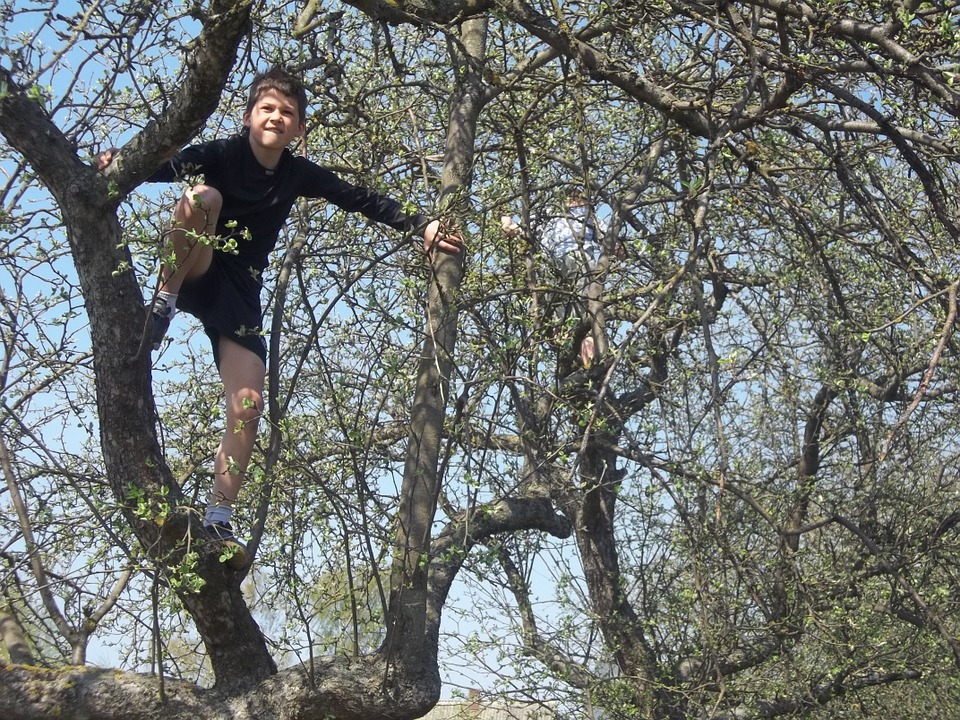
At a place called The Land, in Wrexham, Wales, the ground is littered with pieces of wood, old tires, packing crates, and shopping carts. It looks like a junkyard, but it isn’t. It’s a playground.
There’s also a fire pit, hammers and saws, and a rope swing across a creek. Some of the equipment can be dangerous, but the people who run the playground believe that letting children take some risks is good for them.
The Land was created by Claire Griffiths, who has two children of her own. She wanted to build a space where children could play the way they wanted and experiment with different things, without a lot of rules. (There are adult supervisors on duty, but they are only there to help if there’s a problem.)
Playgrounds in schools and public parks are usually built to be as safe as possible. Slides and climbing structures can’t be too tall. Swings are made out of rubber belts instead of wooden boards. Teeter-totters bounce on springs instead of going all the way up and down. Even the ground is usually covered with wood chips or rubber to make it softer.
Most of the safety rules were created in the 1980s, after a few bad accidents happened on playgrounds. Some children were seriously hurt in these accidents. Their parents said the playground equipment wasn’t safe enough, and the people that ran the playgrounds had to pay large amounts of money to those parents. After that, schools and cities began changing playgrounds to make them as safe as possible.
But extra-safe playgrounds have not really made much of a difference in the total number of total accidents. In fact, there have been more accidents where children have broken an arm or a leg. Some experts believe that this is because children aren’t as careful when they run on a rubber surface because they don’t think it will hurt if they fall.
Meanwhile, children are missing out on the good things that risky play can teach them.
Letting children do things that seem a little dangerous – like climbing trees, riding bikes really fast, playing near water or handling sharp tools – actually teaches them how to stay safe. When children have small accidents, they learn how to recognize danger and avoid worse accidents.
Children who are allowed to take some risks become more confident and independent. They get better at climbing, balancing and other physical skills. They also get better at problem-solving and teamwork.
Many experts also believe that “safe” playgrounds are too boring. They say that if playgrounds were more challenging and exciting, kids would probably play outside more and get more exercise.
Some “adventure” playgrounds are now being built in Canada, with high climbing structures and things like rope walkways or even ziplines. But playgrounds don’t need to have expensive equipment to give children a chance for more adventurous play. Trees and rocks, water and mud, and loose objects like cardboard boxes, old tires, and pieces of wood can provide hours of fun and a chance to develop new skills.
Related Links
EarthPLAY Canada: Connecting Kids to Nature Through Play: https://www.youtube.com/watch?v=ektdIJ1BfZ4
The Land (15-minute documentary about an adventure playground in North Wales, U.K.) https://www.youtube.com/watch?v=4t9vq9bu3II
CURRICULUM CONNECTIONS
By Kathleen Tilly
Writing/Discussion Prompt
Imagine you were to design your own “adventure” playground. What would it look like? What materials would you include? Is there anything you wouldn’t incorporate into your playground? Why not?
Reading Prompt: Point of View
For the most part, this article presents the view that “adventure” playground are positive because “‘safe’ playgrounds are too boring.” Imagine if a safety inspector, a parent or a young child wrote this article. What would their point of view be and how would it sound similar/different?
Junior
Identify the point of view presented in texts, ask questions to identify missing or possible alternative points of view, and suggest some possible alternative perspectives (OME, Reading: 1.9).
Intermediate
Identify the point of view presented in texts, including increasingly complex or difficult texts; give evidence of any biases they may contain; and suggest other possible perspectives (OME, Reading: 1.9).
Language Feature: Verbs
There are several verbs (action words) in this article that describe what children do in playgrounds, such as swing, climb, play etc.
Find all of the verbs in this article related to playing and then think of at least 7 more.







